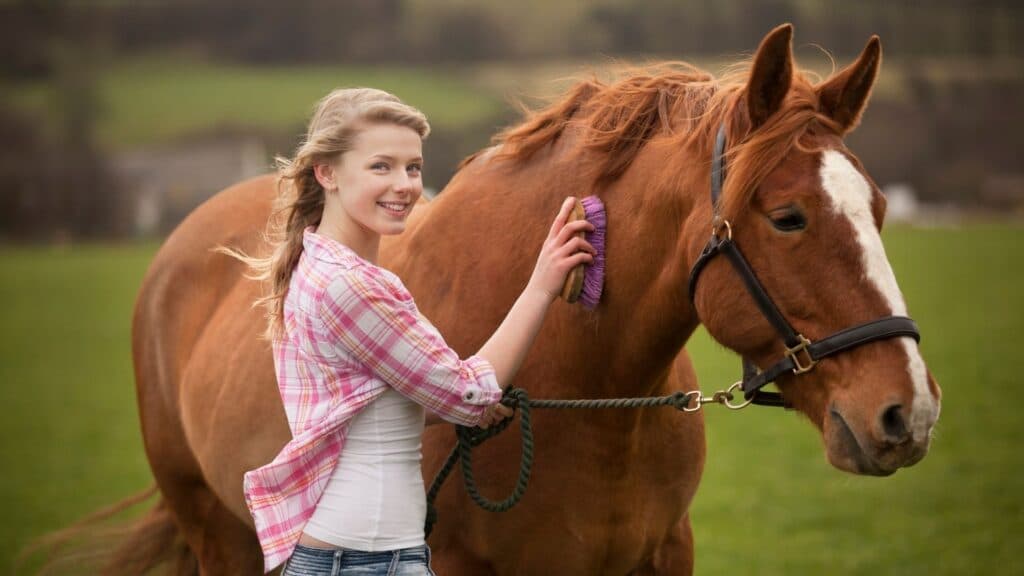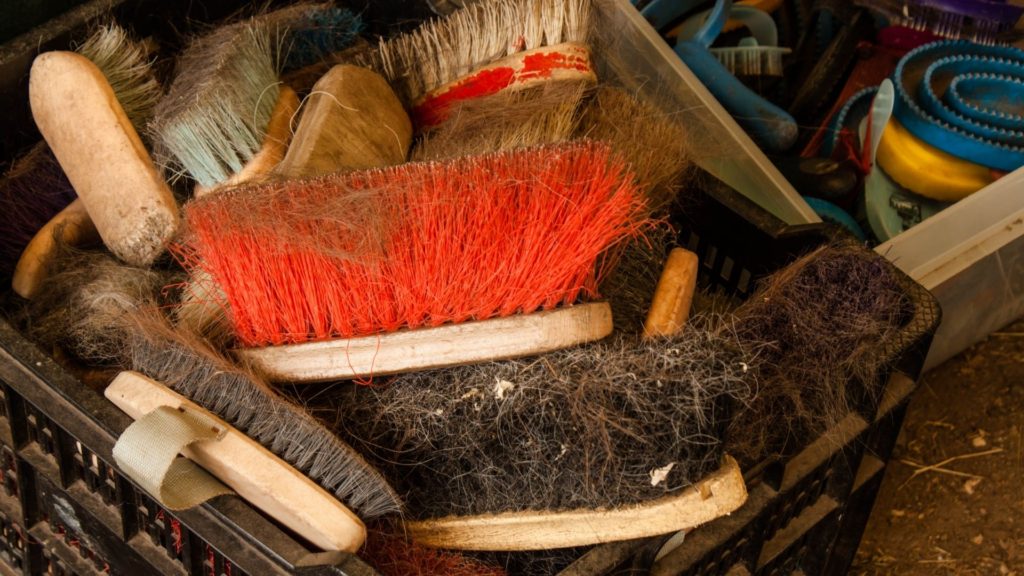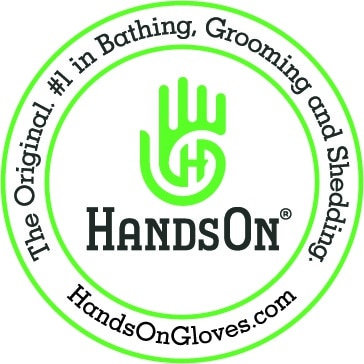Last updated: December 6, 2022
Any links on this page that lead to products on Amazon are affiliate links and I earn a commission if you make a purchase. Thanks in advance – I really appreciate it!
There are many enjoyable things about owning a horse, such as riding it around a course, testing your skills against other riders, and the joy of teaching them new routines. But there are a few parts of owning a horse that is less fun; one of these is grooming your horse.
Horses should be brushed before riding to ensure the saddle area is free from debris. After riding, your horse needs cleaning to remove sweat and accumulated dirt. Though it’s common for horses to hate this process, there are some things you can do to groom them without as much fuss.
Though some owners avoid grooming their horses because of aggressive reactions, this is often a mistake and could expose them to injury. Instead, you’ll need to teach the horse how to accept being brushed.
Grooming gloves come in various styles and are a great way to get your horse ready for a saddle. Click on the ad below to learn about the innovative grooming gloves from HandsOnGloves.
Brushing a horse before riding is essential.
Most horses like the attention they get when you brush them but even if they didn’t, it’s an essential part of owning a horse. Grooming your horse cleans its coat, helps you bond with the animal, and is an opportunity to check it for injuries.
Before riding, you need to ensure there is no debris like rocks or fur tangles. These can get caught beneath the saddle and cause injury to your horse. In some cases, this can cause saddle sores.

Saddle sores can present as areas where the hair is missing or as blister-like lumps. If you suspect that this has happened, you need to dismount, remove the saddle, and examine the area.
If it looks like a severe condition, contact your vet. In most cases, these will be minor injuries and can be treated with time. Unless you’re in an extreme rush, all horses should be brushed before saddling.
This serves multiple purposes; first, it cleans the saddle and the cinch area of dirt and debris, and second, it gives us a chance to check the horse for injuries.
We typically start brushing at the poll with a curry comb to loosen dirt. Always brush with the growth direction of the hair. We go over the horse’s entire body with a stiff curry comb except for its head, lower legs, where it’s a little sensitive.
Prices pulled from the Amazon Product Advertising API on:
Product prices and availability are accurate as of the date/time indicated and are subject to change. Any price and availability information displayed on [relevant Amazon Site(s), as applicable] at the time of purchase will apply to the purchase of this product.
This process loosens dirt and dead skin and brings it to the surface. We follow the curry brushing with a soft brush to remove all the curry brush left behind; at this time, we also include the horse’s head and lower legs.
After you finish brushing, wipe between the horse’s legs with a sponge and clean the sheath. Then we check each foot and clean the hoofs with a pick.
It is also vital to detangle the horse’s mane and tail to stay ahead of severe tangling problems and help the hair grow. If the mane and tail are neglected, they bunch up and knot, making it difficult to straighten, and you typically break and pull out hair or have to cut out the knots.
Some commercial detangler sprays are useful. Here is a link to a popular brand sold on Amazon with a 4.6 out of 5-star rating. It’s been reviewed by over 300 customers; click here to read what they have to say about this product.
Because infections spread quickly in a barn, we wash our grooming tools between uses and try to keep a separate set of grooming tools for each horse.

Brush your horse after riding it.
After riding, you’ll need to brush the horse again. This allows you to check your horse for any new injuries or sore areas before turning him out, and it also removes sweat and debris.
During the ride, sweat and debris accumulate. It would help if you wiped this away to make sure that the horse isn’t uncomfortable. Often behaviors like rolling in the sand after a ride are the horses’ way of trying to get rid of this sweat themselves.
While it’s most important to brush before and after a ride, you should be doing it even if you aren’t heading out for a ride. This can help you spot potential injuries.
Remember, not every injury will affect their performance. If you’re not paying close attention, things like scratches can go unnoticed, though they’ll be hurting your horse.
Grooming might also help you train your horse. It will give you a reason to tie them to a hitching post and teach them the importance of standing still. This can slowly start to get them to trust you, making the saddling process easier down the track.
Why Does My Horse Hate Being Brushed?
A horse may hate being brushed because you are rough with the horse; it hurts the animal or relates it to an unpleasant experience. If you only brush your horse before riding hard, then it may associate it with hard work.
Daily handling is an excellent opportunity to bond with your horse and should be included not only on days you ride but on leisure days as well. If done correctly, it teaches the animal the manners you expect from him.
It’s preferable to tie your horse in a common area when grooming so that he is comfortable in the spot. We tie our horses with cross ties in the wash rack or a stall tie-ring.
When grooming your horse, stay calm, and avoid jerky motions. Don’t let the horse dictate to you, but be aware of sensitive locations that may aggravate him.

As your grooming becomes routine, horses usually enjoy the attention and bond with you. It’s essential to follow a sequence and schedule to get your horse more accepting of brushing.
Horses react to being brushed differently. For some, it’s the favorite part of their day. But, for others, it might make them feel uncomfortable. As a result, they’ll start to lash out. If you’re not careful, you might even up getting bitten.
In some cases, your horse might react like this because of the brush you’re using. If your horse has a thin coat, you might want to re-think using a thickly bristled brush.
You’ll also need to make sure that you’re using the right brush for the task. If you’re not familiar, this article lists the brushes and their functions. In other cases, you could be using the right brush, and your horse is still reacting poorly.
This can be because they have poor manners. You’ll need to make sure that they get used to standing still while brushing from a young age. A good indication that they might have poor manners is if the behavior is part of a recurring pattern.
For example, do they stand still when you’re putting on the saddle? Learning how to deal with a poorly mannered horse can be a long process. The only solution is to invest time in training them to stop negative behavior.
While this can be a lot of effort, it can get progressively worse if you don’t do it. If they don’t exhibit this behavior regularly, it might be a sign that they are more sensitive to brushing.
This can be the case with thinly coating breeds. When you notice this, try to desensitize them. To do this, start brushing parts that don’t cause a reaction. Then, slowly, begin to clean the surrounding areas. This video will walk you through some of the critical grooming steps that you’ll need to take before riding a horse.
Though it can take a while, you’ll eventually be able to brush them without any discomfort.
What Does Sudden Sensitivity Mean?
Your horse might suddenly decide it doesn’t like to be brushed. This can be a sign of a potential skin injury. When you notice this behavior, contact a vet.
It’s rare for a horse to decide they don’t want you to brush them suddenly. This is made even more mysterious if the change of mood occurs unprompted. In most cases, this will have nothing to do with your relationship.
Instead, it can be a sign that your horse has an undiagnosed injury. When you’re brushing over a skin injury, it’s common for the horse to react. In some cases, they might display pain.
In others, they can act aggressively, trying to get you to stop touching them and aggravating the wound. If you suspect this might be the case, contact a vet as quickly as possible.
The faster they diagnose the problem, the better the prognosis will be. Being able to spot these injuries early is one of the reasons why regular grooming is so important.
Final Thoughts
Brushing a horse before and after riding is essential. You’ll be removing sweat and debris, preparing the horse to be saddled up. It will also stop them from developing saddle sores, which can be very uncomfortable for them.
Because of this, you’ll need to make grooming a regular part of your routine. There are a few reasons why they might hate being brushed. The reasons can range from bad behavior and sensitivity to an undiagnosed skin injury.
Once you know what’s causing the reaction, you can start looking for ways to treat it, making brushing your horse a more enjoyable experience.
FAQ
Why does my horse bite me when I’m brushing him?
Horses often reach back and bite owners when they are brushing them, it’s typically a sign of disrespect and you need to stop this behavior. Keep your horse looking forward, when he begins to turn back towards you, immediately push his head forward. You’re the boss so take control.
Do horses like to be petted?
Most horses like attention, being petted and rubbed, and it’s a great way to develop a connection with them. When you are getting to know your animal, it’s typically a best practice to focus on the side of its body rather than the nose or face.

About the Author: Miles Henry
Lifelong Horseman | Racehorse Owner | Published Author
Miles Henry brings over 25 years of hands-on experience training and owning Thoroughbred racehorses. Raised with Quarter Horses and Appaloosas, he’s spent a lifetime learning from horses—on the track, in the barn, and in the field. Today, he runs a small but successful racing stable in Louisiana and shares real-world insights on HorseRacingSense.com, helping horse owners, fans, and bettors navigate the sport with confidence.
📚 Books: View Miles’s books on Amazon »
🎧 Podcast Guest: Animal Tales Ep. 32 |
YouTube Interview
📩 Newsletter: Sign up for racing tips and horse care advice »
🔗 Follow Miles:
Twitter |
Facebook |
YouTube



